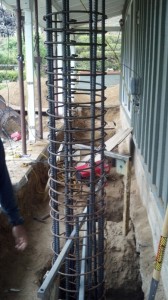It is common to see substructural engineers or foundation designers using 2012 IBC, Section 1807.3.2.1 to proportion drilled shaft (drilled pier) foundations. If you have for example a flag pole or a light pole structure, this is understandable. But when a structural engineer designs a deep foundation by just using the nonconstrained formula we need to be cautious.
| d = 0.5 A{1 + [1 + (4.36h/A)]1/2} | (Equation 18-1) |
1- If you will notice, Equation 18-1, does not contain the moment term. So if your lateral load has an arm to it, you are forced to abandon this equation.
2- Eqn. 18-1 is limited to a depth of 12 ft (3.66 m) and if your required embedment depth exceeds 12 ft, you are required to find another analysis method.
3- Most soils reports limit lateral soil pressure to something like 2,500 psf/ft. That means if your induced lateral pressure at one third embedment (S1) exceeds this value, the you are compelled to find new alternate approach.
4- We don’t know how much deflection takes place at the top of the drilled pier due to this lateral load by using Eqn 18-1.
5- Section 1806.3.4 allows doubling the given passive resistance if 0.5″(13 mm) lateral deflection does not adversely affect the foundation. There are three problems with this – (First, doubling the passive resistance is risky. We usually calculate this value ignoring wall friction & only factor the ultimate passive by 1.25 to 1.50 to arrive at the allowable passive resistance. By multiplying it by 2, means that you have just increased the geotechnical engineer’s values by 133% to 160%. Second, if we have a pole foundation near a descending slope, we can’t justify doubling the passive resistance as the passive wedge is interrupted. Third, if the geotechnical engineer used Coulomb’s method with say -phi/2 as wall friction angle and the angle of internal friction exceeds 32 Degrees, then the computed allowable passive resistance is already on the unconservative side and doubling this passive values is asking for a foundation distress).
We assumed your lateral force was a line load & not a distributed load & we also assumed the origin of this equation (use of steel piles) is similar to the performance of cast in place drilled piles.
In summary, if you have a bending moment, embedment depth more than 12 ft or just don’t want to risk exceeding the ultimate passive resistance of the soils, use a drilled pier software for complete lateral pier analysis.

